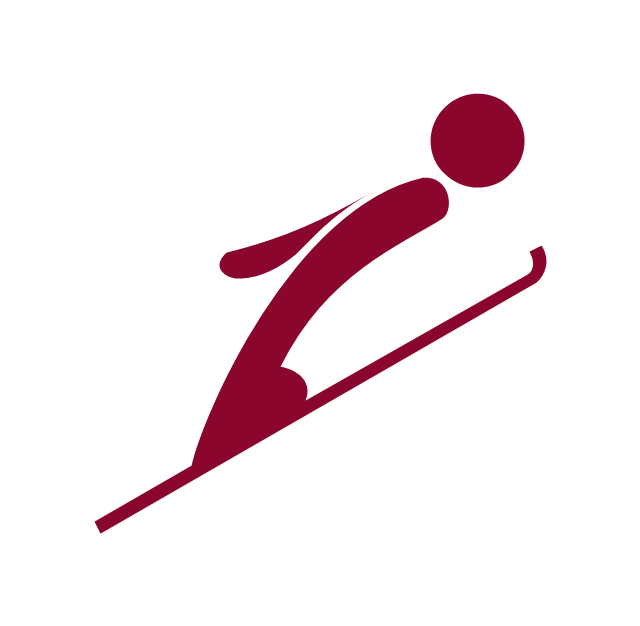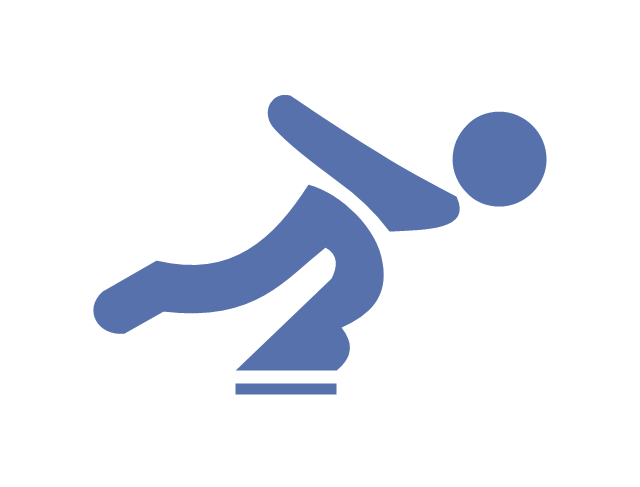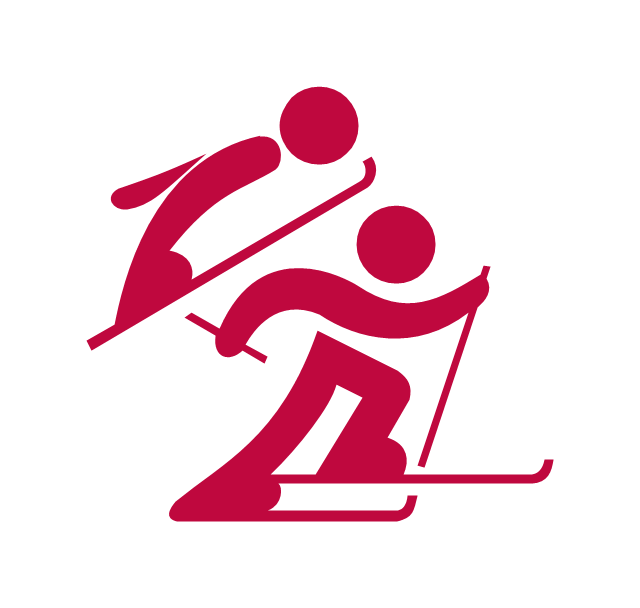"Skeleton is a fast winter sliding sport in which an individual person rides a small sled down a frozen track while lying face down, during which athletes experience forces up to 5g. It originated in St. Moritz, Switzerland as a spin-off from the popular British sport of Cresta sledding. Although skeleton "sliders" use equipment similar to that of Cresta "riders", the two sports are different: while skeleton is run on the same track used by bobsleds and luge, Cresta is run on Cresta-specific sledding tracks only. Skeleton sleds are steered using torque provided by the head and shoulders. The Cresta toboggan does not have a steering or braking mechanism although the Cresta riders use rakes on their boots in addition to shifting body weight to help steer and brake. The sport of skeleton can be traced to 1882, when soldiers in Switzerland constructed a toboggan track between the towns of Davos and Klosters. While toboggan tracks were not uncommon at the time, the added challenge of curves and bends in the Swiss track distinguished it from those of Canada and the United States. ...
In 1923, the Federation Internationale de Bobsleigh et de Tobogganing (FIBT) was established as the governing body of the sport. Soon afterward, in 1926, the International Olympic Committee declared bobsleigh and skeleton as Olympic sports and adopted the rules of the St. Moritz run as the officially recognized Olympic rules. It was not until 2002, however, that skeleton itself was added permanently to the Olympic program with the 2002 Winter Olympics in Salt Lake City, Utah." [Skeleton (sport). Wikipedia]
The vector icon example "Skeleton" represents one of 20 symbols from the Winter sports pictograms library for the ConceptDraw PRO diagramming and vector drawing software.
The design elements library Winter sports pictograms is included in the Winter Sports solution from the Sport area of ConceptDraw Solution Park. www.conceptdraw.com/ solution-park/ sport-winter
In 1923, the Federation Internationale de Bobsleigh et de Tobogganing (FIBT) was established as the governing body of the sport. Soon afterward, in 1926, the International Olympic Committee declared bobsleigh and skeleton as Olympic sports and adopted the rules of the St. Moritz run as the officially recognized Olympic rules. It was not until 2002, however, that skeleton itself was added permanently to the Olympic program with the 2002 Winter Olympics in Salt Lake City, Utah." [Skeleton (sport). Wikipedia]
The vector icon example "Skeleton" represents one of 20 symbols from the Winter sports pictograms library for the ConceptDraw PRO diagramming and vector drawing software.
The design elements library Winter sports pictograms is included in the Winter Sports solution from the Sport area of ConceptDraw Solution Park. www.conceptdraw.com/ solution-park/ sport-winter
"Figure skating is a sport and activity in which individuals, duos, or groups perform on figure skates on ice. The four Olympic disciplines are men's singles, ladies' singles, pair skating, and ice dancing. Non-Olympic disciplines include synchronized skating and four skating. In senior-level competition, skaters generally perform two programs (short and long) which, depending on the discipline, may include spins, jumps, moves in the field, lifts, throw jumps, death spirals, and other elements or moves.
The blade has a groove on the bottom creating two distinct edges – inside and outside. In figure skating, the skater should skate on one edge of the blade and not on both at the same time, which is referred to as a flat edge. Skates used in single and pair skating have a set of large, jagged teeth called toe picks on the front of the blade. Ice dancing blades are an inch shorter in the rear and have smaller toe picks.
Figure skaters compete at various levels from beginner up to the Olympic level (senior) at local, national, and international competitions. The International Skating Union (ISU) regulates international figure skating judging and competitions. These include the Winter Olympic Games, the World Championships, the World Junior Championships, the European Championships, the Four Continents Championships, and the Grand Prix series (senior and junior).
The sport is also associated with show business. Major competitions generally conclude with exhibition galas, in which the top skaters from each discipline perform non-competitive programs. Many skaters, both during and after their competitive careers, also skate in ice shows which run during the competitive season and the off-season." [Figure skating. Wikipedia]
The vector icon example "Figure skating" represents one of 20 symbols from the Winter sports pictograms library for the ConceptDraw PRO diagramming and vector drawing software.
The design elements library Winter sports pictograms is included in the Winter Sports solution from the Sport area of ConceptDraw Solution Park. www.conceptdraw.com/ solution-park/ sport-winter
The blade has a groove on the bottom creating two distinct edges – inside and outside. In figure skating, the skater should skate on one edge of the blade and not on both at the same time, which is referred to as a flat edge. Skates used in single and pair skating have a set of large, jagged teeth called toe picks on the front of the blade. Ice dancing blades are an inch shorter in the rear and have smaller toe picks.
Figure skaters compete at various levels from beginner up to the Olympic level (senior) at local, national, and international competitions. The International Skating Union (ISU) regulates international figure skating judging and competitions. These include the Winter Olympic Games, the World Championships, the World Junior Championships, the European Championships, the Four Continents Championships, and the Grand Prix series (senior and junior).
The sport is also associated with show business. Major competitions generally conclude with exhibition galas, in which the top skaters from each discipline perform non-competitive programs. Many skaters, both during and after their competitive careers, also skate in ice shows which run during the competitive season and the off-season." [Figure skating. Wikipedia]
The vector icon example "Figure skating" represents one of 20 symbols from the Winter sports pictograms library for the ConceptDraw PRO diagramming and vector drawing software.
The design elements library Winter sports pictograms is included in the Winter Sports solution from the Sport area of ConceptDraw Solution Park. www.conceptdraw.com/ solution-park/ sport-winter
"A 'Luge' ... is a small one- or two-person sled on which one sleds supine (face up) and feet-first. Steering is done by flexing the sled's runners with the calf of each leg or exerting opposite shoulder pressure to the seat. ... Luge is also the name of an Olympic sport. Of the three Olympic sliding sports, which include bobsleigh and skeleton, luge is the fastest and most dangerous. Lugers can reach speeds of 140 km per hour (87 mph). ...
Street luge is a recent innovation of the sport. It is considered an extreme sport, as well as an Olympic sport.
Lugers compete against a timer and are timed to a thousandth of a second, making luge one of the most precisely timed sports in the world." [Luge. Wikipedia]
The vector icon example "Luge" represents one of 20 symbols from the Winter sports pictograms library for the ConceptDraw PRO diagramming and vector drawing software.
The design elements library Winter sports pictograms is included in the Winter Sports solution from the Sport area of ConceptDraw Solution Park. www.conceptdraw.com/ solution-park/ sport-winter
Street luge is a recent innovation of the sport. It is considered an extreme sport, as well as an Olympic sport.
Lugers compete against a timer and are timed to a thousandth of a second, making luge one of the most precisely timed sports in the world." [Luge. Wikipedia]
The vector icon example "Luge" represents one of 20 symbols from the Winter sports pictograms library for the ConceptDraw PRO diagramming and vector drawing software.
The design elements library Winter sports pictograms is included in the Winter Sports solution from the Sport area of ConceptDraw Solution Park. www.conceptdraw.com/ solution-park/ sport-winter
"Freestyle skiing is a form of skiing which originally encompassed three disciplines: aerials, moguls, and ski ballet. Today, freestyle skiing consists of aerial, moguls, skicross, boardercross, Ski half-pipe, Snowboard half-pipe and Slopestyle and have become part of the Olympics. ...
The International Ski Federation (FIS) recognized freestyle as a sport in 1979 and brought in new regulations regarding certification of athletes and jump techniques in an effort to curb the dangerous elements of the competitions. The first World Cup series was staged in 1980 and the first World Championships took place in 1986 in Tignes, France. Freestyle skiing was a demonstration event at the 1988 Winter Olympics in Calgary. Mogul skiing was added as an official medal event at the 1992 Winter Olympics in Albertville, and the aerials event was added for the 1994 Winter Olympics in Lillehammer. ...
Currently there are two main branches of freestyle skiing: one encompassing the more traditional events of moguls and aerials, and a newer branch often called new school, comprising events such as halfpipe, big air, slopestyle, and big mountain or free-skiing. Freeskiing shares characteristics with street skateboarding, BMX, and inline skating. New school skiing has grown so much that new ski companies were created, companies that strictly make twin-tip skis — skis that are designed for taking off and landing "fakie", or "switch" (backwards) on jumps and rails." [Freestyle skiing. Wikipedia]
The vector icon example "Freestyle skiing" represents one of 20 symbols from the Winter sports pictograms library for the ConceptDraw PRO diagramming and vector drawing software.
The design elements library Winter sports pictograms is included in the Winter Sports solution from the Sport area of ConceptDraw Solution Park. www.conceptdraw.com/ solution-park/ sport-winter
The International Ski Federation (FIS) recognized freestyle as a sport in 1979 and brought in new regulations regarding certification of athletes and jump techniques in an effort to curb the dangerous elements of the competitions. The first World Cup series was staged in 1980 and the first World Championships took place in 1986 in Tignes, France. Freestyle skiing was a demonstration event at the 1988 Winter Olympics in Calgary. Mogul skiing was added as an official medal event at the 1992 Winter Olympics in Albertville, and the aerials event was added for the 1994 Winter Olympics in Lillehammer. ...
Currently there are two main branches of freestyle skiing: one encompassing the more traditional events of moguls and aerials, and a newer branch often called new school, comprising events such as halfpipe, big air, slopestyle, and big mountain or free-skiing. Freeskiing shares characteristics with street skateboarding, BMX, and inline skating. New school skiing has grown so much that new ski companies were created, companies that strictly make twin-tip skis — skis that are designed for taking off and landing "fakie", or "switch" (backwards) on jumps and rails." [Freestyle skiing. Wikipedia]
The vector icon example "Freestyle skiing" represents one of 20 symbols from the Winter sports pictograms library for the ConceptDraw PRO diagramming and vector drawing software.
The design elements library Winter sports pictograms is included in the Winter Sports solution from the Sport area of ConceptDraw Solution Park. www.conceptdraw.com/ solution-park/ sport-winter
"Ski jumping is a sport in which skiers go down a take-off ramp, jump and attempt to land as far as possible down the hill below. In addition to the length of the jump, judges give points for style. The skis used for ski jumping are wide and long (260 to 275 centimetres (100 to 108 in)). Ski jumping is predominantly a winter sport, performed on snow, and is part of the Winter Olympic Games, but can also be performed in summer on artificial surfaces – porcelain or frost rail track on the inrun, plastic on the landing hill. Ski jumping belongs to the nordic type of competitive skiing." [Ski jumping. Wikipedia]
The vector icon example "Ski jumping" represents one of 20 symbols from the Winter sports pictograms library for the ConceptDraw PRO diagramming and vector drawing software.
The design elements library Winter sports pictograms is included in the Winter Sports solution from the Sport area of ConceptDraw Solution Park. www.conceptdraw.com/ solution-park/ sport-winter
The vector icon example "Ski jumping" represents one of 20 symbols from the Winter sports pictograms library for the ConceptDraw PRO diagramming and vector drawing software.
The design elements library Winter sports pictograms is included in the Winter Sports solution from the Sport area of ConceptDraw Solution Park. www.conceptdraw.com/ solution-park/ sport-winter
"Speed skating, or speedskating, is a competitive form of ice skating in which the competitors race each other in traveling a certain distance on skates. Types of speed skating are long track speed skating, short track speed skating, and marathon speed skating. In the Olympic Games, long-track speed skating is usually referred to as just "speed skating", while short-track speed skating is known as "short track". The ISU, the governing body of both ice sports, refers to long track as "speed skating" and short track as "short track skating". ...
The sport originates from pack-style events held in North America and was officially sanctioned in the 1970s, becoming an Olympic sport in 1992. Although this form of speed skating is newer, it is growing faster than long-track speed skating, largely because short track can be done on an ice hockey rink rather than a long-track oval." [Speed skating. Wikipedia]
The vector icon example "Speed skating" represents one of 20 symbols from the Winter sports pictograms library for the ConceptDraw PRO diagramming and vector drawing software.
The design elements library Winter sports pictograms is included in the Winter Sports solution from the Sport area of ConceptDraw Solution Park. www.conceptdraw.com/ solution-park/ sport-winter
The sport originates from pack-style events held in North America and was officially sanctioned in the 1970s, becoming an Olympic sport in 1992. Although this form of speed skating is newer, it is growing faster than long-track speed skating, largely because short track can be done on an ice hockey rink rather than a long-track oval." [Speed skating. Wikipedia]
The vector icon example "Speed skating" represents one of 20 symbols from the Winter sports pictograms library for the ConceptDraw PRO diagramming and vector drawing software.
The design elements library Winter sports pictograms is included in the Winter Sports solution from the Sport area of ConceptDraw Solution Park. www.conceptdraw.com/ solution-park/ sport-winter
"Bobsleigh or bobsled is a winter sport in which teams of two or four make timed runs down narrow, twisting, banked, iced tracks in a gravity-powered sled. The timed runs are combined to calculate the final score.
The various types of sleds came several years before the first tracks were built in St. Moritz, Switzerland, where the original bobsleds were adapted upsized luge/ skeleton sleds designed by the adventurously wealthy to carry passengers. All three types were adapted from boys' delivery sleds and toboggans.
Competition naturally followed, and to protect the working class and rich visitors in the streets and byways of St Moritz, bobsledding was eventually banned from the public highway. In the winter of 1903/ 1904 the Badrutt family, owners of the historic KulmHotel and the Palace Hotel, allowed Emil Thoma to organise the construction of the first familiarly configured 'half-pipe' track in the Kulm Hotel Park, ending in the village of Cresta. It has hosted the sport during two Olympics and is still in use today.
International bobsleigh competitions are governed by the Fédération Internationale de Bobsleigh et de Tobogganing (FIBT). National competitions are often governed by bodies such as the United States Bobsled and Skeleton Federation and Bobsleigh Canada Skeleton." [Bobsleigh. Wikipedia]
The vector icon example "Bobsleigh" represents one of 20 symbols from the Winter sports pictograms library for the ConceptDraw PRO diagramming and vector drawing software.
The design elements library Winter sports pictograms is included in the Winter Sports solution from the Sport area of ConceptDraw Solution Park. www.conceptdraw.com/ solution-park/ sport-winter
The various types of sleds came several years before the first tracks were built in St. Moritz, Switzerland, where the original bobsleds were adapted upsized luge/ skeleton sleds designed by the adventurously wealthy to carry passengers. All three types were adapted from boys' delivery sleds and toboggans.
Competition naturally followed, and to protect the working class and rich visitors in the streets and byways of St Moritz, bobsledding was eventually banned from the public highway. In the winter of 1903/ 1904 the Badrutt family, owners of the historic KulmHotel and the Palace Hotel, allowed Emil Thoma to organise the construction of the first familiarly configured 'half-pipe' track in the Kulm Hotel Park, ending in the village of Cresta. It has hosted the sport during two Olympics and is still in use today.
International bobsleigh competitions are governed by the Fédération Internationale de Bobsleigh et de Tobogganing (FIBT). National competitions are often governed by bodies such as the United States Bobsled and Skeleton Federation and Bobsleigh Canada Skeleton." [Bobsleigh. Wikipedia]
The vector icon example "Bobsleigh" represents one of 20 symbols from the Winter sports pictograms library for the ConceptDraw PRO diagramming and vector drawing software.
The design elements library Winter sports pictograms is included in the Winter Sports solution from the Sport area of ConceptDraw Solution Park. www.conceptdraw.com/ solution-park/ sport-winter
"The Nordic combined is a winter sport in which athletes compete in both cross-country skiing and ski jumping. ...
Until the 1950s, the cross-country race was held first, followed by the ski jumping. This was reversed as the difference in the cross-country race tended to be too big to overcome in ski jumping.
There are currently four kinds of Nordic combined events, of which three - the individual, sprint and team - are World Championship events. A fourth, the mass start, was introduced at the 2009 championships at Liberec, Czech Republic. At the autumn 2008 FIS meeting in Zurich, Switzerland, it was agreed that the individual and sprint events would be replaced by compact versions of the events. These new versions would also be contested at the 2009 world championships in Liberec. ... Current events included in the Olympics are the men's individual NH/ 10 km and the men's team 4 x 5 km." [Nordic combined. Wikipedia]
The vector icon example "Nordic combined" represents one of 20 symbols from the Winter sports pictograms library for the ConceptDraw PRO diagramming and vector drawing software.
The design elements library Winter sports pictograms is included in the Winter Sports solution from the Sport area of ConceptDraw Solution Park. www.conceptdraw.com/ solution-park/ sport-winter
Until the 1950s, the cross-country race was held first, followed by the ski jumping. This was reversed as the difference in the cross-country race tended to be too big to overcome in ski jumping.
There are currently four kinds of Nordic combined events, of which three - the individual, sprint and team - are World Championship events. A fourth, the mass start, was introduced at the 2009 championships at Liberec, Czech Republic. At the autumn 2008 FIS meeting in Zurich, Switzerland, it was agreed that the individual and sprint events would be replaced by compact versions of the events. These new versions would also be contested at the 2009 world championships in Liberec. ... Current events included in the Olympics are the men's individual NH/ 10 km and the men's team 4 x 5 km." [Nordic combined. Wikipedia]
The vector icon example "Nordic combined" represents one of 20 symbols from the Winter sports pictograms library for the ConceptDraw PRO diagramming and vector drawing software.
The design elements library Winter sports pictograms is included in the Winter Sports solution from the Sport area of ConceptDraw Solution Park. www.conceptdraw.com/ solution-park/ sport-winter
"Ice hockey is a team sport played on ice in which skaters use sticks to shoot a hard rubber hockey puck into their opponent's net to score points. ...
A team usually consists of four lines of three forwards, three pairs of defensemen, and two goalies. Five members of each team skate up and down the ice trying to take the puck and score a goal against the opposing team. Each team has a goaltender who tries to stop the puck from going into the goal.
... In North America, the National Hockey League (NHL) is the highest level for men's hockey and the most popular. Ice hockey is the official national winter sport of Canada, where the game enjoys immense popularity. The first organized game was played on March 3, 1875, in Montreal.
162 of 177 medals at the IIHF World Championships have been taken by seven nations: Canada, the Czech Republic, Finland, Russia, Slovakia, Sweden and the United States. Of the 66 medals awarded in men's competition at the Olympics from 1920, only six medals did not go to one of those countries." [Ice hockey. Wikipedia]
The vector icon example "Ice hockey" represents one of 20 symbols from the Winter sports pictograms library for the ConceptDraw PRO diagramming and vector drawing software.
The design elements library Winter sports pictograms is included in the Winter Sports solution from the Sport area of ConceptDraw Solution Park. www.conceptdraw.com/ solution-park/ sport-winter
A team usually consists of four lines of three forwards, three pairs of defensemen, and two goalies. Five members of each team skate up and down the ice trying to take the puck and score a goal against the opposing team. Each team has a goaltender who tries to stop the puck from going into the goal.
... In North America, the National Hockey League (NHL) is the highest level for men's hockey and the most popular. Ice hockey is the official national winter sport of Canada, where the game enjoys immense popularity. The first organized game was played on March 3, 1875, in Montreal.
162 of 177 medals at the IIHF World Championships have been taken by seven nations: Canada, the Czech Republic, Finland, Russia, Slovakia, Sweden and the United States. Of the 66 medals awarded in men's competition at the Olympics from 1920, only six medals did not go to one of those countries." [Ice hockey. Wikipedia]
The vector icon example "Ice hockey" represents one of 20 symbols from the Winter sports pictograms library for the ConceptDraw PRO diagramming and vector drawing software.
The design elements library Winter sports pictograms is included in the Winter Sports solution from the Sport area of ConceptDraw Solution Park. www.conceptdraw.com/ solution-park/ sport-winter
- Bobsleigh | Sport pictograms . Olympic Games | Design elements ...
- Sport pictograms . Olympic Games | Winter Sports . Olympic Games ...
- Snowboard - Winter sports pictograms | Design elements - Winter ...
- Infographics with winter sports pictograms
- Winter Sports | Sport pictograms . Olympic Games | Design elements ...
- Freestyle skiing | Sport pictograms . Olympic Games | Design ...
- Short track speed skating | Sport pictograms . Olympic Games ...
- Sport pictograms . Olympic Games | Wheelchair curling - Winter ...
- Sport pictograms . Olympic Games | Luge | Design elements - Winter ...
- Sport pictograms . Olympic Games | Vector clipart - People | Skeleton ...
- Winter Olympics - Luge | Luge - Winter sports pictograms | Winter ...
- Sport pictograms . Olympic Games | Winter Sports . Olympic Games ...
- Ice hockey | Sport pictograms . Olympic Games | Ice sledge hockey |
- Nordic combined | Sport pictograms . Olympic Games | Cross-country ...
- Sport pictograms . Olympic Games | Skeleton - Winter sports ...
- Sport pictograms . Olympic Games | Figure skating | Design elements ...
- Design elements - Winter sports pictograms | Sport Area | Sochi ...
- Sport pictograms . Olympic Games | Alpine skiing, paralympic ...
- Biathlon, paralympic - Winter sports pictograms | Biathlon - Winter ...
- Sochi 2014 Olympics - Men's hockey tournament schedule ...
- ERD | Entity Relationship Diagrams, ERD Software for Mac and Win
- Flowchart | Basic Flowchart Symbols and Meaning
- Flowchart | Flowchart Design - Symbols, Shapes, Stencils and Icons
- Flowchart | Flow Chart Symbols
- Electrical | Electrical Drawing - Wiring and Circuits Schematics
- Flowchart | Common Flowchart Symbols
- Flowchart | Common Flowchart Symbols








